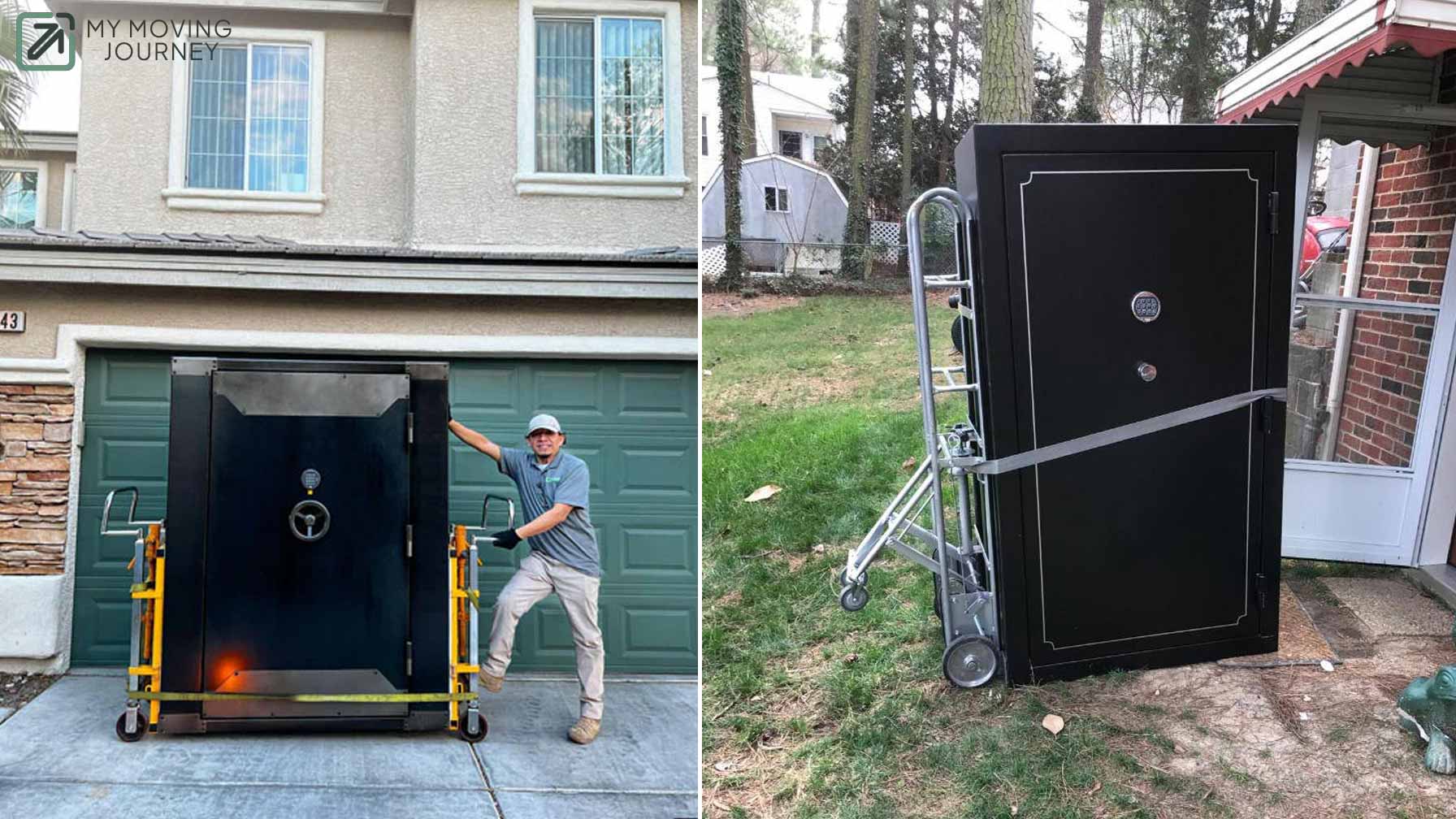Preparation is the key to success. This couldn’t be truer when it comes to moving a heavy safe. It’s a stressful task, but with the right tools, strategies, and preparation, it’s entirely possible to do it safely.
Many people don’t realize how heavy a safe can be until they need to move one. Did you know that the average safe weighs anywhere between 300 to 1,000 pounds? Gun safes, in particular, can tip the scales at over 1,500 pounds! That’s a serious piece of equipment to move.
Read and learn How to Move a Gun Safe.
When considering how to move a safe, it’s essential to recognize just how crucial preparation is. Improper handling could lead to injury, damage to your property, or even damage to the safe itself.
In fact, around 36% of DIY movers report some type of property damage while attempting to move large, heavy objects like safes, and over 20% report personal injury during the process. Even something as simple as overlooking a small step can lead to costly repairs or medical bills.
Moreover, it's important to note that safes are designed to be difficult to move for security reasons. Manufacturers intentionally make them bulky and awkward to handle, adding to their effectiveness as secure storage units.
But this design also means that moving a safe requires careful planning, the right equipment, and sometimes a helping hand. Whether you are relocating across town or just shifting it across the room, taking the proper steps to handle this weight is non-negotiable.
So, if you have ever wondered how to move a heavy safe, keep reading to find out how.
Why Moving a Safe is a Big Deal
Safes are designed to be heavy for security reasons, often weighing several hundred pounds. The average gun safe, for example, can weigh between 300 to 500 pounds, while larger units can exceed 1,000 pounds.
Safes are also bulky and can be tricky to manoeuvre through narrow spaces or stairs. Attempting this without proper preparation can result in damaged property, serious injury, or even a ruined safe. In short, moving a heavy safe is no walk in the park, but with the right approach, it’s doable!
Tools You Will Need
Before you get started, gather all the right tools. Here's a basic checklist:
- Heavy-duty appliance dolly: Essential for moving heavy objects. Choose one that can support the weight of your safe.
- Moving blankets: To wrap the safe and protect it from scratches.
- Furniture sliders or plywood: To prevent floor damage when sliding the safe.
- Tie-down straps: To secure the safe onto the dolly.
- High-quality gloves and close-toed shoes For protection and grip.
With these essentials in hand, you’re ready to tackle this challenge.
Learn How To Use Plastic Wrap For Moving.
Steps to Move a Large Safe
Here’s the step-by-step breakdown of how to move a heavy safe:
1. Empty the Safe
Before you even think about lifting it, empty the safe. Removing all valuables, firearms, or other items will significantly reduce their weight and reduce the risk of internal damage during the move.
2. Measure the Safe and Your Pathway
You'll want to know the safe's dimensions and weight, along with the size of the doorways and hallways you'll be moving it through. This will help you plan for tricky turns and ensure a safe fit through every doorway. Measure carefully!
3. Prepare the Floor and Pathway
Safes are heavy and dragging them across floors can cause damage. Lay down plywood or moving blankets to protect your flooring, especially if you have hardwood or tile. Also, make sure the path is clear of obstacles and furniture. This avoids accidents and ensures the move goes smoothly.
4. Strap the Safe to a Dolly
Now comes the heavy lifting. Tilt the safe onto the appliance dolly and secure it with tie-down straps. This ensures the safe stays in place while moving it. If you're moving the safe downstairs, consider using a stair-climbing dolly for added ease and safety.
5. Move Slowly and Carefully
When moving a safe, patience is key. Tilt the dolly back and roll slowly, maintaining balance. Be particularly cautious at corners and on stairs. If needed, use a ramp to help manoeuvre the safe into a moving truck or up steep inclines. This is especially crucial when moving a heavy safe with a dolly.
6. Secure the Safe for Transport
Once the safe is loaded onto the truck, ensure it is tightly secured with straps. A heavy safe shifting in transit can be dangerous, damaging both the safe and the vehicle.
Common Mistakes When Moving a Heavy Safe
Mistakes can happen, but many are preventable. Here are some of the most frequent errors people make:
- Not Using Enough Help: Safes are heavy! Don’t attempt to move it alone. Enlist at least two to three people to help, depending on the size of the safe.
- Skipping the Measurements: Failing to measure doorways or staircases can literally leave you in a tight spot. Always double-check that the safe can fit through all passages.
- Ignoring the Floor Protection: Dragging a safe across hardwood or tiled floors without protection is a surefire way to damage your home.
- Rushing the Move: Moving too fast increases the risk of injury and accidents. Take your time!
Extra Tips for Moving a Safe Safely
- Hire Professionals: If you’re unsure, it’s worth hiring professional movers who are experienced in moving large safes. They’ll have specialized tools like stair climbers and hydraulic lifts that make the job safer and faster.
- Use Proper Lifting Techniques: Always lift with your legs, not your back. This simple advice can save you from serious injury.
- Rent Equipment if Necessary: Don’t have an appliance dolly or tie-down straps? Equipment rental services like U-Haul or Home Depot can be lifesavers for DIY movers.
Related article for extra safety:
Moving a Safe with a Dolly
Using a dolly is one of the most effective ways to move a large safe. It distributes the weight evenly and allows you to roll it instead of lifting it. Just make sure the dolly can handle the safe's weight. Appliance dollies are typically rated for several hundred pounds, but verifying this before moving is crucial.




